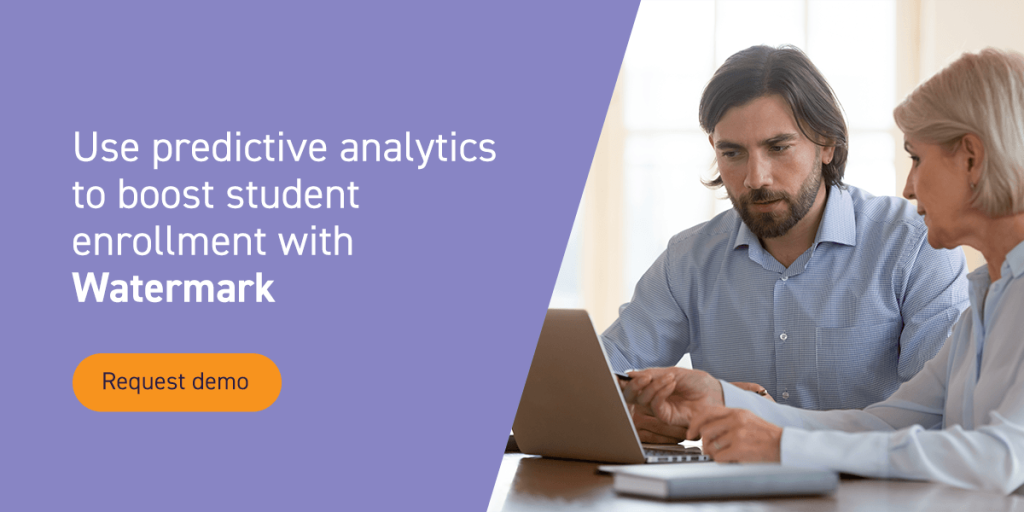




Higher education is fast approaching a cliff: an enrollment cliff. Due to the sharp decline in birth rates following the Great Recession, 2025 will see the smallest class of 18-year-old college freshmen than ever before. And that trend is expected to continue over the following years, as from 2025-2030, the number of American high school graduates will shrink by a whopping 15%.
Add to that situation the growing sense of skepticism young people have been feeling toward higher education, and it’s clear institutions need to take action now to save their futures. Incorporating technology and big data into your admissions and enrollment strategy can help protect your institution’s bottom line and improve student outcomes.
Many enrollment management teams have found that adding predictive analytics to their workflows has helped them successfully boost enrollment numbers. Predictive analytics algorithms can analyze massive quantities of institutional data to accurately forecast trends and events, giving you the insights you need to bring in more students.

Here are three of the most promising applications for predictive analytics in higher ed enrollment.
Creating an excellent prospect experience that starts around sophomore year of high school is key to effective higher education recruitment. As prospective students begin investigating their options, the enrollment team can collect useful data like:
With this data, enrollment managers can determine which prospective students to prioritize in outreach efforts. This information can also tell them what types of marketing and recruiting strategies are most likely to be successful.
Retaining students is more profitable overall than enrolling new ones, which is why enrollment managers need to make strategic, informed decisions about which students to admit. But with ongoing labor shortages and thousands of applications to process every year, enrollment management teams often struggle to keep up.
Leveraging big data and predictive analytics can help your admissions officers determine which students are most likely to complete their education much faster than reviewing applications by hand.
Although it’s true that higher education enrollment is declining across the board, we can’t breeze past the fact that certain student populations are driving this downward trend.
More specifically, young American men of all financial and ethnic backgrounds are now much less likely to pursue higher education than their female peers. Students of color also face discrimination that can significantly reduce their likelihood of enrolling in a degree program.
Although administrators typically use predictive analytics to identify which students are most likely to stay at the institution, they can also use these algorithms to understand what kinds of support the incoming class needs to prepare them for success. Providing a strong support structure helps improve outcomes for all students, but especially for minority student populations.
While data analytics can help your enrollment teams save valuable time and energy in evaluating incoming students, the following tricks can ensure you get the most out of your analytics tool.
Having a well-developed vision and plan is essential for any data analytics initiative because it provides you with a clear roadmap toward your goals. Predictive analytics can help you understand where your weaknesses are so you can develop effective solutions.
And you can track your progress toward those goals using integrated tools like student success software. Student success solutions use artificial intelligence (AI) and predictive analytics to monitor student progress from enrollment to graduation. If the platform notices a trend that could indicate a student is at risk, it will notify the student’s support team to help get them back on track.
You’ll also want to make sure you get buy-in from key institutional stakeholders like deans and provosts. When your institution’s leadership supports your initiative, you’re significantly more likely to succeed — whether that means boosting enrollment numbers or increasing retention.
Even though machines are literally incapable of complex thought, they can still discriminate against marginalized populations and potentially hamper your institution’s efforts to increase student diversity.
For example, demonstrated interest is one of the most reliable factors enrollment managers can pay attention to when recruiting students. The more a prospect engages with your institution by attending events like open houses, information sessions, and campus tours, the more likely they will be to submit a deposit for the upcoming semester.
However, critics of predictive analytics have pointed out that this could inadvertently disadvantage marginalized students. For one thing, students from lower-income households are much less likely to have enough time and money to travel to your campus. Even if they’re otherwise promising candidates, their low demonstrated interest score could impact their chances of admission.
Your team can reduce the risk of bias affecting enrollment yield by using a mix of data from various sources instead of relying on one data stream.
Your data is only as valuable as you make it, which is why it’s so important to invest in robust, integrative student success software. Many institutions use disparate systems that don’t communicate, which often causes data silos and bottlenecks that negatively impact enrollment as well as other areas of your institution.
That’s why it’s important to invest in a unified system that encompasses multiple solutions. Fully integrated software suites store your data in a centralized location, creating a single source of truth your tools can draw from to run analytics and create reports.
Having one source of data ensures accuracy and transparency, which is important for more than just enrollment. A unified data stream also simplifies auditing and accreditation processes.
These insights provide you with data you can use to identify strengths and weaknesses in your enrollment and retention strategies, which empowers your institution to make real changes that boost enrollment in the long term.
At Watermark, we’re committed to improving higher education outcomes through the power of big data. Our comprehensive suite of integrative solutions uses powerful AI and predictive analytics algorithms to transform your student data into valuable insights you can use to make the most informed decisions.
We prioritize the people behind our nation’s institutions. That’s why our solutions seamlessly integrate with external programs like the most popular learning management systems (LMS). Easy interoperability reduces friction, boosts efficiency, and ensures a smooth user experience.
Ready to get started? See our industry-leading software solutions in action today by requesting a live demo.






























































































































































































































































































































































































